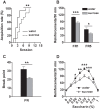Sugar overconsumption during adolescence selectively alters motivation and reward function in adult rats
- PMID: 20174565
- PMCID: PMC2824808
- DOI: 10.1371/journal.pone.0009296
Sugar overconsumption during adolescence selectively alters motivation and reward function in adult rats
Abstract
Background: There has been a dramatic escalation in sugar intake in the last few decades, most strikingly observed in the adolescent population. Sugar overconsumption has been associated with several adverse health consequences, including obesity and diabetes. Very little is known, however, about the impact of sugar overconsumption on mental health in general, and on reward-related behavioral disorders in particular. This study examined in rats the effects of unlimited access to sucrose during adolescence on the motivation for natural and pharmacological rewards in adulthood.
Methodology/principal findings: Adolescent rats had free access to 5% sucrose or water from postnatal day 30 to 46. The control group had access to water only. In adulthood, rats were tested for self-administration of saccharin (sweet), maltodextrin (non-sweet), and cocaine (a potent drug of abuse) using fixed- and progressive-ratio schedules, and a concentration-response curve for each substance. Adult rats, exposed or not exposed to sucrose, were tested for saccharin self-administration later in life to verify the specificity of adolescence for the sugar effects. Sugar overconsumption during adolescence, but not during adulthood, reduced the subsequent motivation for saccharin and maltodextrin, but not cocaine. This selective decrease in motivation is more likely due to changes in brain reward processing than changes in gustatory perception.
Conclusions/significance: Sugar overconsumption induces a developmental stage-specific chronic depression in reward processing that may contribute to an increase in the vulnerability to reward-related psychiatric disorders.
Conflict of interest statement
Figures





Similar articles
-
Protracted motivational dopamine-related deficits following adolescence sugar overconsumption.Neuropharmacology. 2018 Feb;129:16-25. doi: 10.1016/j.neuropharm.2017.11.021. Epub 2017 Nov 13. Neuropharmacology. 2018. PMID: 29146502
-
Intense sweetness surpasses cocaine reward.PLoS One. 2007 Aug 1;2(8):e698. doi: 10.1371/journal.pone.0000698. PLoS One. 2007. PMID: 17668074 Free PMC article.
-
Long-lasting deficits in hedonic and nucleus accumbens reactivity to sweet rewards by sugar overconsumption during adolescence.Eur J Neurosci. 2016 Mar;43(5):671-80. doi: 10.1111/ejn.13149. Epub 2016 Jan 13. Eur J Neurosci. 2016. PMID: 26762310
-
Factors influencing the effects of nutritive and non-nutritive sweeteners on energy intake and body weight in rats.Appetite. 1988;11 Suppl 1:16-9. Appetite. 1988. PMID: 3056262 Review.
-
Sugar addiction: pushing the drug-sugar analogy to the limit.Curr Opin Clin Nutr Metab Care. 2013 Jul;16(4):434-9. doi: 10.1097/MCO.0b013e328361c8b8. Curr Opin Clin Nutr Metab Care. 2013. PMID: 23719144 Review.
Cited by
-
Systemic Delivery of a Brain-Penetrant TrkB Antagonist Reduces Cocaine Self-Administration and Normalizes TrkB Signaling in the Nucleus Accumbens and Prefrontal Cortex.J Neurosci. 2016 Aug 3;36(31):8149-59. doi: 10.1523/JNEUROSCI.2711-14.2016. J Neurosci. 2016. PMID: 27488635 Free PMC article.
-
Children's propensity to consume sugar and fat predicts regular alcohol consumption in adolescence.Public Health Nutr. 2018 Dec;21(17):3202-3209. doi: 10.1017/S1368980018001829. Epub 2018 Aug 24. Public Health Nutr. 2018. PMID: 30139409 Free PMC article.
-
Maternal high-fat diet during pregnancy and lactation reduces the appetitive behavioral component in female offspring tested in a brief-access taste procedure.Am J Physiol Regul Integr Comp Physiol. 2014 Apr 1;306(7):R499-509. doi: 10.1152/ajpregu.00419.2013. Epub 2014 Feb 5. Am J Physiol Regul Integr Comp Physiol. 2014. PMID: 24500433 Free PMC article.
-
Applying behavioral economics-based approaches to examine the effects of liquid sucrose consumption on motivation.Appetite. 2023 Jul 1;186:106556. doi: 10.1016/j.appet.2023.106556. Epub 2023 Apr 10. Appetite. 2023. PMID: 37044175 Free PMC article.
-
Reward mechanisms in obesity: new insights and future directions.Neuron. 2011 Feb 24;69(4):664-79. doi: 10.1016/j.neuron.2011.02.016. Neuron. 2011. PMID: 21338878 Free PMC article. Review.
References
-
- Mintz SW. Time, sugar and sweetness. Marx Persp. 1979;2(4):56–73. - PubMed
-
- Jacobson MF. Washington, DC: Center for Science in the Public Interest; 2005. Liquid Candy: How Soft Drinks Are Harming Americans' Health. 2nd ed.
-
- World Health Organization. Geneva: WHO; 2003. Diet, Nutrition and the Prevention of Chronic Diseases. Joint WHO/FAO Expert consultation. WHO Technical Report Series 916. - PubMed
-
- Popkin BM, Nielsen SJ. The sweetening of the world's diet. Obes Res. 2003;11:1325–1332. - PubMed
-
- Guthrie JF, Morton JF. Food sources of added sweeteners in the diets of Americans. J Am Diet Assoc. 2000;100 (1):43–48, 51. - PubMed
Publication types
MeSH terms
Substances
LinkOut - more resources
Full Text Sources
Medical

